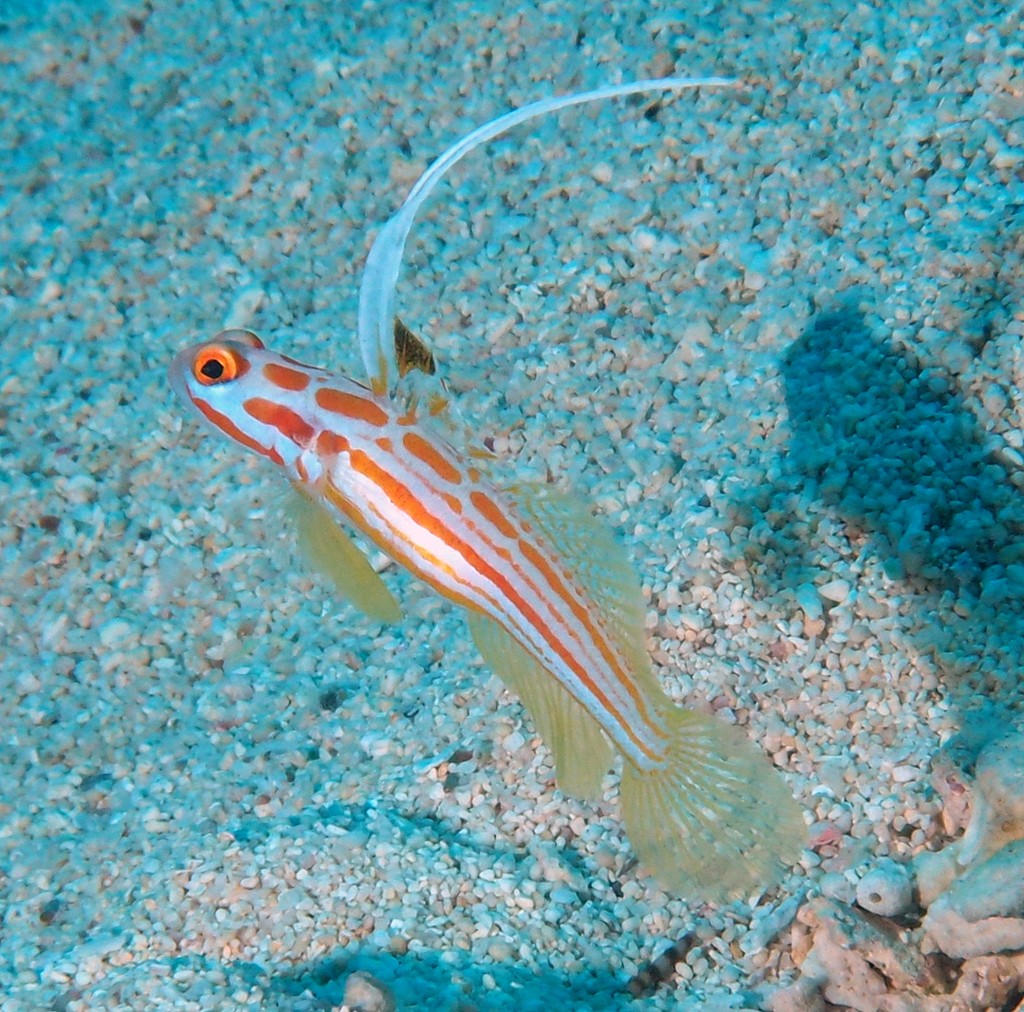STONOGOBIOPS YASHA - (YOSHINO & SHIMADA, 2001)
Actinopterygii (Gigaclass) > Actinopteri (Class) > Teleostei (Subclass) > Gobiiformes (Order) > Gobioidei (Suborder) > Gobiidae (Family) > Gobiinae (Subfamily) > Stonogobiops (Genus)
Poisson gobie à points rouges, Orange-striped shrimpgoby, Yasha-haze, ヤシャハゼ,
Description
Dorsal spines (total): 7, first dorsal fin extremely long, with longest spine, 64-109 % in SL; Dorsal soft rays (total): 10-12; Anal spine: 1; Anal soft rays: 10-11; Pectoral fin rays: 16-17; Pelvic fin rays: I, 5; Vertebrae: 10 + 17 = 27; Segmented caudal fin rays: 16-17; Branched caudal fin rays: 14-15; Longitudinal scale series: 82-96; Transversal scale rows: 24-27; Head and body moderately compressed; Body moderately elongate, body depth: 5.6 (5.0-5.6)-6.3 (5.9-6.7) in SL at base of pelvic fin and anal origin, respectively. Head large: 3.6 (3.2-3.6) in SL. Mouth rather large; Gape moderately oblique, forming an angle of about 30° to the horizontal axis of the head and body. Caudal fin rounded; United pelvic fins, well developed frenum present; Head without scales; Cycloid scales covering body, somewhat embedded. Max. length: 4.7 cm SL (female). Depth range: 15 - 40 m.
Color
Body white, with three reddish-orange stripes. Head with two median cephalic sensory pores. First two spines and membrane of dorsal fin white. Black spot on middle of first dorsal fin distally.
Etymology
Stonogobiops: from the Greek, στόνυξ (stonux) = a sharp point as of a rock or the boar's tusk or the barb of the fish + from Latin, gobius = gudgeon, goby + from Ancient Greek, óps = eye, face, appearance. Referring to large vomerine teeth of Stonogobiops dracula (Polunin & Lubbock, 1977).
yasha: from Middle Chinese 夜叉 (yæh cha), itself a transliteration of Sanskrit यक्ष (yaksha) = a broad class of nature spirits or minor deities who appear in Hindu, Buddhist, and Jain mythology. May be male or female, benevolent or malevolent. Also a traditional female devil in Japan, having a long pair of canines on upper jaw. Referring to this goby’s large prevomerine teeth.
Original description: Stonogobiops yasha Yoshino & Shimada, 2001 - Type locality: off Maeda Cape, 26°27'N, 127°47'E, Onna Village, Okinawa Prefecture, Okinawa Island, depth: 38 meters.
Distribution
Bali, Palau, Japan and New Caledonia.
Biology
Occurs in the outer reef slopes; Often found in pairs, hovering a few centimeters above the sandy bottom at the entrance to its burrow. Symbiotic with the red-and-white barred shrimp, Alpheus randalli (Banner & Banner, 1980).
Last update: 9, April 2023
Poisson gobie à points rouges, Orange-striped shrimpgoby, Yasha-haze, ヤシャハゼ,
Description
Dorsal spines (total): 7, first dorsal fin extremely long, with longest spine, 64-109 % in SL; Dorsal soft rays (total): 10-12; Anal spine: 1; Anal soft rays: 10-11; Pectoral fin rays: 16-17; Pelvic fin rays: I, 5; Vertebrae: 10 + 17 = 27; Segmented caudal fin rays: 16-17; Branched caudal fin rays: 14-15; Longitudinal scale series: 82-96; Transversal scale rows: 24-27; Head and body moderately compressed; Body moderately elongate, body depth: 5.6 (5.0-5.6)-6.3 (5.9-6.7) in SL at base of pelvic fin and anal origin, respectively. Head large: 3.6 (3.2-3.6) in SL. Mouth rather large; Gape moderately oblique, forming an angle of about 30° to the horizontal axis of the head and body. Caudal fin rounded; United pelvic fins, well developed frenum present; Head without scales; Cycloid scales covering body, somewhat embedded. Max. length: 4.7 cm SL (female). Depth range: 15 - 40 m.
Color
Body white, with three reddish-orange stripes. Head with two median cephalic sensory pores. First two spines and membrane of dorsal fin white. Black spot on middle of first dorsal fin distally.
Etymology
Stonogobiops: from the Greek, στόνυξ (stonux) = a sharp point as of a rock or the boar's tusk or the barb of the fish + from Latin, gobius = gudgeon, goby + from Ancient Greek, óps = eye, face, appearance. Referring to large vomerine teeth of Stonogobiops dracula (Polunin & Lubbock, 1977).
yasha: from Middle Chinese 夜叉 (yæh cha), itself a transliteration of Sanskrit यक्ष (yaksha) = a broad class of nature spirits or minor deities who appear in Hindu, Buddhist, and Jain mythology. May be male or female, benevolent or malevolent. Also a traditional female devil in Japan, having a long pair of canines on upper jaw. Referring to this goby’s large prevomerine teeth.
Original description: Stonogobiops yasha Yoshino & Shimada, 2001 - Type locality: off Maeda Cape, 26°27'N, 127°47'E, Onna Village, Okinawa Prefecture, Okinawa Island, depth: 38 meters.
Distribution
Bali, Palau, Japan and New Caledonia.
Biology
Occurs in the outer reef slopes; Often found in pairs, hovering a few centimeters above the sandy bottom at the entrance to its burrow. Symbiotic with the red-and-white barred shrimp, Alpheus randalli (Banner & Banner, 1980).
Last update: 9, April 2023
